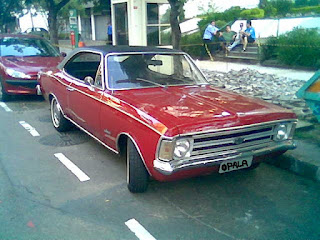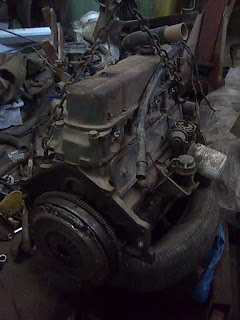Among spark-ignited engines, the Chevrolet 153 is still one of my favorites. Mostly known in my homeland Brazil for its 2.5L version used in the Opala, plus a very limited availability as a supposedly fuel-saver alternative to the 3rd-gen straight-6 in the light-duty versions of the full-size truck range, it's still praised by its outstanding reliability and ease of maintenance. The gear-driven valvetrain is a feature I still enjoy in this engine, much like the Volkswagen's boxer, even though the OHV layout is often pointed out as a downside when compared to modern designs with overhead camshaft(s).
With cast-iron block and head, the Chevrolet 153 was a cheap-to-build engine, becoming a mainstay for GM's former South African branch (and later its licensee Delta Motor Corporation when GM was forced to divest from South Africa during the Apartheid) also in smaller displacements at least until the late-80s. The smallest version however was the 1.8L one made in Argentina, where it was fitted to the local Opel K-180 derivative of the T-Platform, instead of the Isuzu G-series fitted to its Brazilian Chevrolet Chevette counterpart initially in 1.4L version (which everywhere else was OHV) to be subsequently increased to 1.6L and a later 1.0L version meant to take benefit of lower taxes which took effect in Brazil in the early '90s. Even though the Isuzu G-series had OHV versions in other markets, all the ones made in Brazil were OHC, which might not be an issue at all.
At least until '99, the rated power of the engine was also considered for tax purposes in Brazil, with earlier versions of the Opel Astra B sedan fitted with the 1.8L Family 2 engine detuned to 99PS until the displacement became the most important parameter for that matter. Since then, most cars with engines bigger than 2.0L are liable to higher taxes, which has led to some weird situations when certain models such as the Jeep Renegade are fitted with larger engines only for export and restricted on the local market to undersized ones which in the end become overstressed gas-guzzlers. As long as there is enough low-end torque, I could reallycare less about power and all the bragging involved on marketing strategies...
As the Chevrolet 153 engine has been proven suitable to address the need for displacements between 1.8L to 3.0L (this late made only as a marine and stationary/industrial powerplant) with a single block design, rendering it able to cover from a small sedan such as the Brazilian Cobalt up to a regional version of the Colorado which retains the S10 nameplate for reasons that an American won't understand. Sure it would pose challenging to offer some smaller engines to address the needs of other segments which call for a lower displacement, but it's far from rendering the 153 unsuitable to retain its role as a favorite of commercial operators and the fleet market for exemple.
Eventually it could seem harder to consider any perspective for the 153 in a foreseeable future with European transverse-engined Opel designs adapted to become a Chevrolet in Latin America or even remain an Opel in South Africa, the mid-engined Pontiac Fiero with itsIron Duke engine whose major difference to the 151 and 151-S fitted to later 4-cyl versions of the Brazilian Chevrolet Opala was the crossflow head could've been pointed out as a reason to believe such engine was not totally outdated as it could be fitted transversely too. Even if a crossflow head remained out of question for Brazilian and South African derivatives of the 153, that wouldn't be such a problem. Not being a rev-happy beast, which has proven unsuitable in the Pontiac Fiero due to its sporty design, would also be less relevant in the eyes of the average Brazilian car buyer.
The fuel supply for the Iron Duke, depending on the year of manufacturing and application, was either a carburettor or a throttle-body injection. Sure both would be outdated and most likely unsuitable in newer applications just in case the 153 or the Iron Duke had lasted longer somehow, but it shouldn't be seen as a reason to single it out. Even though some minor redesign of the intake manifold would be needed in order to upgrade the fuel system to a sequential port injection, both engines would've been able to meet emission regulations more stringent than what applied when they were still available in brand-new cars, and maybe could remain at least in some markets with somewhat outdated emission standards, which is the case in most of Latin America, Africa and Middle East.
Since the 153 is essentially a derivative of the low-deck 3rd-generation Chevrolet straight-6 engine, which had a 250cu.in. port-injection version made in Brazil until 2000 and fitted to Argentinian derivatives of the GMT400 trucks instead of the Vortec 4300 V6, it wouldn't be so unrealistic to consider some viability of similar improvements to have been also applied. Most of the brand-loyal Chevrolet customers used to be more conservative anyway, so it wouldn't take too much to keep them interested in a seemingly outdated powerplant as long as it didn't get rendered artificially uncompetitive due to a displacement-biased tax structure.
Naturally it's not reasonable to expect such an ancient engine design to perform the same way a more modern one within a similar displacement range or even some smaller one would, but it doesn't mean they're effectively worthless even in a modern world-class car like the Chevrolet Cruze. Featuring greater low-end torque, it's not unusual for an engine with larger displacement actually provide a better fuel-efficiency eithet at cruising speed or higher loads. Even though in the end the gear ratio also plays an important role when it comes to power (AND TORQUE) delivery at the driving wheels, a higher-displacement engine working understressed coupled to some higher gearing might eventually outlast a newer and more rev-happy one which relies on a shorter gear ratio to enable a similar performance.
South African market retained the previous generation of the Chevrolet Cruze instead of the current one until GM divested once again from SA last year, and maybe the 153 engine could've remained relevant in order to meet local content regulations at a lower cost, since the tooling to manufacture it had already paid itself a long time before its phaseout. GM was struggling to take a profit in most right-hand drive markets anyway, not only switching off all the production in South Africa but also downsizing its operation in India to an export-only business plan. Competition with the Japanese who basically dominate the compact car segment in most large-volume markets has proven unsuccessful for GM, and maybe it could've still held better perspectives if taxation structures allowed it to rely on this seemingly outdated yet versatile engine platform for a longer timeframe.

















I would not really hold my breath for the 153 to save Chevrolet in SA, but I agree it could've had its chance to extend its presence here for a while. Having a cheaper engine that most farmers and the folks at the townships are also familiar with, could've made a difference in terms of easy maintenance.
ReplyDeleteIt's hard to explain to most people who are too biased to see lower displacement as cleaner and more affordable, but this subject makes sense.
ReplyDelete